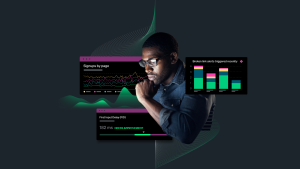In the last 40 years, I’ve seen three truly disruptive technologies: the world wide web in the early 1990s, Steve Jobs’ introduction of the iPhone in 2007, and ChatGPT in late 2022, now the fastest growing app in history.
All three of these technologies share one common trait: they are limitless innovation fractals. In other words, the closer you look and the more you think about how they can be applied to different industries, businesses, and use cases, the larger the number of ideas that are generated, and the ideas seem to go on forever. Limitless innovation leads to massive value creation opportunities, as trillions of dollars of shareholder value have been realized in the decades since the web and the iPhone debuted.
The pace of innovation continues to increase, driven by innovation itself, creating a virtuous cycle of acceleration. Consider that it took the world wide web seven years to reach 100 million users, the iPhone app store 2+ years, and ChatGPT a mere two months.
When the web and the iPhone appeared on the scene, they forced businesses to adopt new ways of interacting with their customers by investing in websites and mobile apps and reimagining business processes along the way. This created opportunities for companies like New Relic to help the world build better applications. And similar to the web and the iPhone, the potential for AI technologies is causing companies to work hard and act fast to build out their AI strategy. New Relic is well positioned to help them.
What is AI observability?
AI observability is the ability to monitor, measure, and understand the behavior and performance of artificial intelligence (AI) systems in real-time. It is a concept that has gained prominence as AI systems become more complex and integrated into various applications and industries.
AI’s ability to analyze and make sense of vast amounts of data has a profound impact on monitoring. AI in monitoring can be used to more accurately detect anomalies and behaviors that indicate threats. It can also be used to make predictive insights based on historical data, as well as automate routine tasks to give teams more time to tend to more complex issues.
Monitoring is a subset of observability. By extension, the goal of AI in observability is to provide insights into the inner workings of AI models, helping developers, data scientists, and operators to identify and address issues, optimize performance, and ensure the reliability and robustness of AI systems.
Why is AI observability important?
AI observability is crucial for several reasons, especially as AI systems are integral to various applications and industries. Here are key reasons why AI observability is essential:
Performance monitoring and optimization
AI observability allows continuous monitoring of key performance metrics, such as accuracy, latency, and resource utilization. Understanding how AI models perform in real-world scenarios helps organizations enhance efficiency and deliver better user experiences.
Issue detection and troubleshooting
Real-time monitoring and logging enable the quick detection of issues or anomalies within AI systems. With detailed logs and metrics, developers and operators can troubleshoot problems, identify root causes, and implement timely solutions.
Enhanced robustness and reliability
AI observability contributes to the robustness and reliability of AI systems by providing insights into their behavior under different conditions. This is particularly important in dynamic environments where data distributions may change over time. Understanding how models respond to variations in input data helps ensure that AI systems maintain accurate and reliable performance.
Compliance and governance
Observability features, such as traceability and explainability, support organizations in meeting regulatory and compliance requirements. Being able to trace the flow of data through the AI system and providing explanations for model decisions are essential for ensuring transparency and accountability, particularly in industries with strict regulatory frameworks.
Quick response to changes
As AI systems evolve and adapt to new data, observing their behavior becomes essential for adapting to changes. AI observability enables organizations to quickly respond to shifts in data patterns, model drift, or changes in the environment. This agility is crucial for maintaining the effectiveness of AI applications over time.
Challenges in AI observability
AI observability is challenging for many reasons, including data complexity, data skew, bias, model drift (or staleness), and more.
- Data complexity: It takes a massive amount of data to generate AI models. Conversely, AI systems generate large amounts of different types of data that must be analyzed and interpreted to monitor AI performance and predict issues.
- Data skew: Data skew occurs when data used for inference no longer reflects the model’s training data. This mismatch happens for many reasons, including data dependencies such as evolving user behavior and seasonal trends, or data integrity issues such as corrupted, missing, or inconsistent data.
- Bias: Biases in training data can lead to inaccurate results. These biases can have a negative impact on fairness and accuracy in AI decisions from inference.
- Lack of standardization: With the newness and rapid evolution of AI and AI observability, universally accepted standards for tracking AI metrics are slow to be established. This makes it difficult to compare different models and track progress effectively.
- Need for integration: Engineering teams and departments often work with their AI tools based on initiatives or simple preference; ensuring compatibility and proper bi-directional data flow into these tools becomes a necessity to ensure a cohesive, holistic environment without disruptions in process or needless ‘swivel-chair’ downtime toggling between tools.
These are characteristics of AI systems, which present a different system flow compared to established DevOps practice. Traditional observability tools may not be capable of tracking and predicting AI systems performance and reliability.
AI observability vs. traditional observability: What’s the difference?
AI observability is the ability to monitor, measure, and understand the behavior and performance of artificial intelligence (AI) systems in real-time. Observable AI requires a different approach to AI monitoring and analytics. Today’s DevOps suite of tools have evolved over time with standardized approaches for end-to-end observability. AI pipelines need the same level of observability. AI data, however, is quite different from traditional observability data, requiring new tools for AI monitoring.
AI systems have their own set of observable AI data to track beyond infrastructure metrics. Such data leads to insight into critical understanding of model accuracy, prediction latency, and data pipeline health. AI observability must trace actions through the entire pipeline to measure data skew, bias, and model staleness, predicting when issues might occur and when models might need retraining.
GenAI and the observability industry
GenAI refers to compound artificial intelligence models that can generate new data based on existing patterns. These models can create anything from realistic images to coherent text, opening up a world of possibilities across various industries. They can also synthesize and understand data at a pace and scale several orders of magnitude more efficiently than existing solutions.
As we continue to witness the rapid advancement of GenAI, it becomes crucial for the observability industry to adapt and evolve to meet new challenges and opportunities. Here are two key ways generative AI will reshape the observability industry.
1. GenAI will change the way we deliver actionable insights.
As the creator of the first GenAI observability assistant in the market, we understand the need for compound AI technology that powers GenAI can analyze vast amounts of data quickly and efficiently, enabling businesses to make more informed decisions. This allows companies to address potential bottlenecks and optimize their software systems for better performance.
GenAI can also automate repetitive tasks and optimize workflows, streamlining the observability process and saving valuable time and resources.
GenAI can dramatically simplify access to deep insights, no longer requiring expert knowledge of sophisticated query interfaces, democratizing the power of observability to every application developer, SRE, product manager, QA engineer and even line of business/C-suite executives.
Working in tandem with GenAI, New Relic offers powerful Agentic Integrations providing a System of Intelligence that bring observability insights and automation right into the tools and interfaces users prefer to work. As an example, New Relic Agentic Integration with ServiceNow goes beyond a simple API data pull to provide deep, mission-critical insights and intelligent recommendations to the tools and workstreams where ServiceNow customers already work. Enterprises embracing New Relic and ServiceNow can automate enterprise workflows, maximize business uptime, and make smarter decisions from real-time insights.
New Relic AI, our in-platform GenAI assistant, works with ServiceNow to identify, prioritize, and address the impact and root cause of issues across your digital landscape. New Relic brings real-time production data like errors, logs, traces, security vulnerabilities, and alerts directly into ServiceNow experiences and workflows. All information and insights will be presented directly within the ServiceNow interfaces in natural language, eliminating tool switching, unlocking access for any user, and speeding up issue resolution. New Relic and ServiceNow provide users with alert intelligence reports that contain alert impact analysis and probable cause theories based on deep analysis of the health of an application. Users can also query specific services, hosts, and system components for performance insights drawn from current performance data and compare it against historical trends and best practices.
New Relic Agentic Integration with ServiceNow empowers today’s enterprise to turn business-critical data into insight. Best-in-class agentic AI brings intelligent observability into Now Assist, resulting in:
- Smarter decisions: provides integrated, actionable insights from all IT & Business data
- Improved efficiency: Automates complex tasks and processes
- Intelligent collaboration: Consolidates and prioritizes teams, tools and interfaces
By Integrating these AI capabilities into our Intelligent Observability Platform, we help businesses optimize their software systems and reduce the time spent on diagnosing and resolving issues.
2. Companies will need to develop their own AI strategies to stay competitive.
Just as the internet and smartphones have become essential for modern business strategies, GenAI will soon become an integral part of every company's growth plan, and organizations will need to adapt and innovate to stay competitive in this new era of AI-driven technology, or risk being left behind.
As companies rush to implement GenAI capabilities, they’ll need to invest in observability products to maintain and monitor these new capabilities. Prompt engineering, competing large language models, fine-tuning, and feedback loops are all essential components to delivering an exceptional user experience. Each of these advances will also drive demand for advanced observability solutions that cater to the unique challenges posed by AI-driven technologies.
How New Relic transforms AI observability
Unlike traditional applications, AI observability demands visibility across a broader tech stack:
- Infrastructure: Monitoring specialized compute (CPUs, GPUs, TPUs) in potentially distributed environments.
- Data: Tracking the health and performance of diverse data storage, including vector databases for AI models.
- Model: Observing model performance, drift, bias, and explainability.
- Orchestration: Monitoring the deployment and scaling of AI workflows and model lifecycle.
- Application: Analyzing traditional performance alongside AI-specific interactions and their impact.
Crucially, AI observability extends beyond standard metrics to encompass accuracy, security, and reliability indicators unique to AI applications. Addressing these complexities is vital for the future of AI.
New Relic AI monitoring delivers comprehensive, end-to-end visibility across your entire AI application stack for optimizing performance, quality, and cost. Important capabilities include:
- Fast, easy setup with auto-instrumentation
- Fast debugging with full AI stack visibility
- End-to-end response tracing to understand the entire AI interaction lifecycle
- Model performance and cost comparisons to choose the optimal model
- More than 50 integrations across the AI ecosystem
This solution gives SREs and AI data engineers visibility and insight across your entire AI stack so they can build and run safe, secure, and responsible AI applications with confidence.
Embracing innovation and bracing for change in the era of AI
Every industry is being transformed by the power of generative AI as we speak. Governments are noticing, VCs are funding AI innovation, and a whole new natural language interface is redefining our relationships with machines. Startups will emerge that will reimagine what can be done with generative AI and its evolutionary trajectory, and they will disrupt market leaders, who will be faced with hard choices about the sustainability of their current business models.
As we embrace this new wave of innovation, it is essential for observability companies to stay at the forefront of this technological shift, helping drive growth and change as this digital transformation accelerates every industry. Those who master its application will be the new market leaders, and those who resist will be left behind. That will lead to the Great Reshuffle in the next several years, and AI-powered approaches will establish the new ranking.
The transformative power of generative AI is undeniable, and its potential to reshape the observability specifically combined with other best-in-class technologies in the industry is immense. Observability companies ingest massive amounts of data and provide analytics, reports, and alerts to help their customers identify patterns, anomalies, and predictions from that data. That is what AI models are designed to do better than humans, and the engines powering the models and the models themselves are getting exponentially faster and more powerful. It is unavoidable that AI will play a central role in observability and that customers will demand the functionality that can only come from AI-powered observability solutions. By integrating AI capabilities into our offerings and developing tailored observability solutions, we hope to lead observability to its next phase, thereby expanding its reach and importance in the software development life cycle.
Generative AI is already reshaping business, culture, creativity, and communication. It is touching every aspect of our lives. As it does, it will also reshape the observability industry. By embracing this technology and its immense potential, we can foster a more connected, efficient, and innovative world for all.
Next steps
Unprecedented visibility, seamless integration, and deep insights into your entire AI stack allow you to confidently make AI a part of all of your applications. New Relic AI helps you to easily identify performance, cost, and quality issues that impact your AI applications. Armed with the right data, you can build trust with customers and partners, and also stay ahead of the curve in the ever-changing AI landscape.
Learn how New Relic is leading the way with observability and generative AI:
- Discover New Relic AI, the first GenAI observability assistant.
- Monitor OpenAI GPT application usage with New Relic.
- Check out these integrations to monitor your full AI stack.
Don't have New Relic yet? Sign up for a free account. Your account includes 100 GB/month of free data ingest, one free full-platform user, and unlimited free basic users.
The views expressed on this blog are those of the author and do not necessarily reflect the views of New Relic. Any solutions offered by the author are environment-specific and not part of the commercial solutions or support offered by New Relic. Please join us exclusively at the Explorers Hub (discuss.newrelic.com) for questions and support related to this blog post. This blog may contain links to content on third-party sites. By providing such links, New Relic does not adopt, guarantee, approve or endorse the information, views or products available on such sites.





